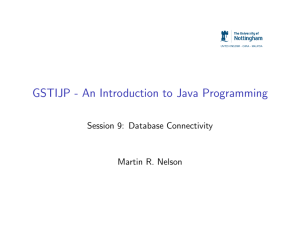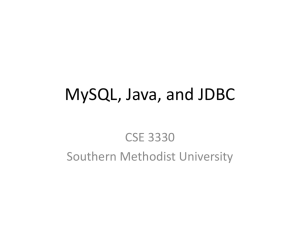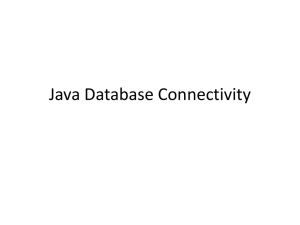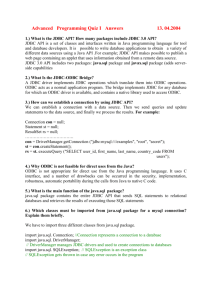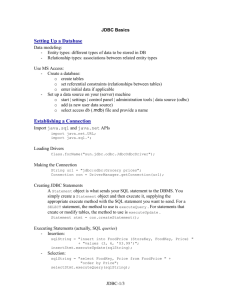Lecture18_257 - Courses - University of California, Berkeley
advertisement
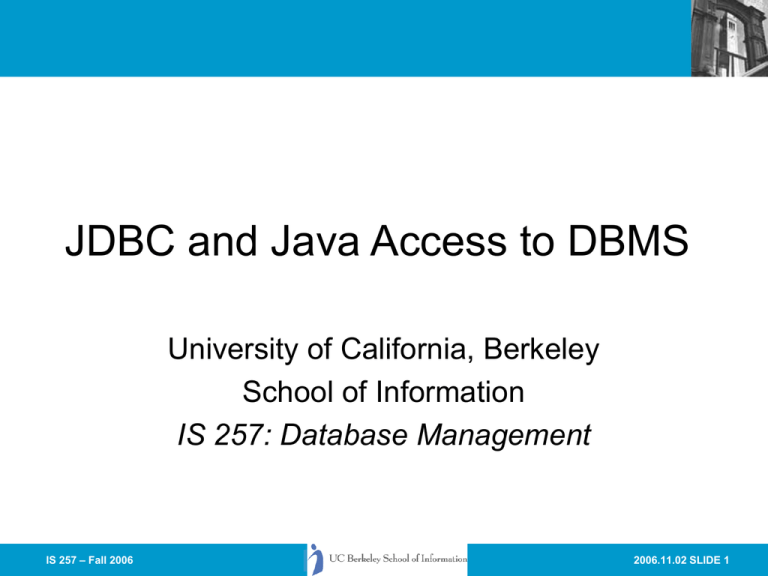
JDBC and Java Access to DBMS
University of California, Berkeley
School of Information
IS 257: Database Management
IS 257 – Fall 2006
2006.11.02 SLIDE 1
Lecture Outline
• Review:
– Object-Relational DBMS
– OR features in Oracle
– OR features in PostgreSQL
– Extending OR databases (examples from
PostgreSQL)
• Java and JDBC
IS 257 – Fall 2006
2006.11.02 SLIDE 2
Lecture Outline
• Object-Relational DBMS
– OR features in Oracle
– OR features in PostgreSQL
• Extending OR databases (examples from
PostgreSQL)
• Java and JDBC
IS 257 – Fall 2006
2006.11.02 SLIDE 3
Object Relational Data Model
• Class, instance, attribute, method, and
integrity constraints
• OID per instance
• Encapsulation
• Multiple inheritance hierarchy of classes
• Class references via OID object
references
• Set-Valued attributes
• Abstract Data Types
IS 257 – Fall 2006
2006.11.02 SLIDE 4
Object Relational Extended SQL (Illustra)
• CREATE TABLE tablename {OF TYPE
Typename}|{OF NEW TYPE typename}
(attr1 type1, attr2 type2,…,attrn typen)
{UNDER parent_table_name};
• CREATE TYPE typename (attribute_name
type_desc, attribute2 type2, …, attrn
typen);
• CREATE FUNCTION functionname
(type_name, type_name) RETURNS
type_name AS sql_statement
IS 257 – Fall 2006
2006.11.02 SLIDE 5
Object-Relational SQL in ORACLE
• CREATE (OR REPLACE) TYPE typename
AS OBJECT (attr_name, attr_type, …);
• CREATE TABLE OF typename;
IS 257 – Fall 2006
2006.11.02 SLIDE 6
Example
• CREATE TYPE ANIMAL_TY AS OBJECT
(Breed VARCHAR2(25), Name
VARCHAR2(25), Birthdate DATE);
• Creates a new type
• CREATE TABLE Animal of Animal_ty;
• Creates “Object Table”
IS 257 – Fall 2006
2006.11.02 SLIDE 7
Constructor Functions
• INSERT INTO Animal values
(ANIMAL_TY(‘Mule’, ‘Frances’,
TO_DATE(‘01-APR-1997’, ‘DD-MMYYYY’)));
• Insert a new ANIMAL_TY object into the
table
IS 257 – Fall 2006
2006.11.02 SLIDE 8
PostgreSQL Classes
• The fundamental notion in Postgres is that of a
class, which is a named collection of object
instances. Each instance has the same
collection of named attributes, and each attribute
is of a specific type. Furthermore, each instance
has a permanent object identifier (OID) that is
unique throughout the installation. Because SQL
syntax refers to tables, we will use the terms
table and class interchangeably. Likewise, an
SQL row is an instance and SQL columns are
attributes.
IS 257 – Fall 2006
2006.11.02 SLIDE 9
Creating a Class
• You can create a new class by specifying the
class name, along with all attribute names and
their types:
CREATE TABLE weather (
city
varchar(80),
temp_lo
int,
-- low temperature
temp_hi
int,
-- high temperature
prcp
real,
-- precipitation
date
date
);
IS 257 – Fall 2006
2006.11.02 SLIDE 10
PostgreSQL
• Postgres can be customized with an arbitrary
number of user-defined data types.
Consequently, type names are not syntactical
keywords, except where required to support
special cases in the SQL92 standard.
• So far, the Postgres CREATE command looks
exactly like the command used to create a table
in a traditional relational system. However, we
will presently see that classes have properties
that are extensions of the relational model.
IS 257 – Fall 2006
2006.11.02 SLIDE 11
Inheritance
CREATE TABLE cities (
name
text,
population
float,
altitude
int -- (in ft)
);
CREATE TABLE capitals (
state
char(2)
) INHERITS (cities);
IS 257 – Fall 2006
2006.11.02 SLIDE 12
Inheritance
• In Postgres, a class can inherit from zero
or more other classes.
• A query can reference either
– all instances of a class
– or all instances of a class plus all of its
descendants
IS 257 – Fall 2006
2006.11.02 SLIDE 13
Non-Atomic Values - Arrays
• The preceding SQL command will create a class
named SAL_EMP with a text string (name), a
one-dimensional array of int4 (pay_by_quarter),
which represents the employee's salary by
quarter and a two-dimensional array of text
(schedule), which represents the employee's
weekly schedule
• Now we do some INSERTSs; note that when
appending to an array, we enclose the values
within braces and separate them by commas.
IS 257 – Fall 2006
2006.11.02 SLIDE 14
PostgreSQL Extensibility
• Postgres is extensible because its operation is catalogdriven
– RDBMS store information about databases, tables, columns,
etc., in what are commonly known as system catalogs. (Some
systems call this the data dictionary).
• One key difference between Postgres and standard
RDBMS is that Postgres stores much more information
in its catalogs
– not only information about tables and columns, but also
information about its types, functions, access methods, etc.
• These classes can be modified by the user, and since
Postgres bases its internal operation on these classes,
this means that Postgres can be extended by users
– By comparison, conventional database systems can only be
extended by changing hardcoded procedures within the DBMS
or by loading modules specially-written by the DBMS vendor.
IS 257 – Fall 2006
2006.11.02 SLIDE 15
Lecture Outline
• Review
– Object-Relational DBMS
– OR features in Oracle
– OR features in PostgreSQL
– Extending OR databases (examples from
PostgreSQL)
• Java and JDBC
IS 257 – Fall 2006
2006.11.02 SLIDE 16
Java and JDBC
• Java is probably the high-level language
used in most software development today
one of the earliest “enterprise” additions to
Java was JDBC
• JDBC is an API that provides a mid-level
access to DBMS from Java applications
• Intended to be an open cross-platform
standard for database access in Java
• Similar in intent to Microsoft’s ODBC
IS 257 – Fall 2006
2006.11.02 SLIDE 17
JDBC Architecture
• The goal of JDBC is to be a generic SQL
database access framework that works for
any database system with no changes to
the interface code
Java Applications
JDBC API
JDBC Driver Manager
IS 257 – Fall 2006
Driver
Driver
Driver
Oracle
MySQL
Postgres
2006.11.02 SLIDE 18
JDBC
• Provides a standard set of interfaces for
any DBMS with a JDBC driver – using
SQL to specify the databases operations.
Resultset
Resultset
Resultset
Statement
PreparedStatement
CallableStatement
Application
Connection
DriverManager
Oracle Driver
ODBC Driver
Postgres Driver
Oracle DB
ODBC DB
Postgres DB
IS 257 – Fall 2006
2006.11.02 SLIDE 19
JDBC Simple Java Implementation
import java.sql.*;
import oracle.jdbc.*;
public class JDBCSample {
public static void main(java.lang.String[] args) {
try {
// this is where the driver is loaded
//Class.forName("jdbc.oracle.thin");
DriverManager.registerDriver(new OracleDriver());
}
catch (SQLException e) {
System.out.println("Unable to load driver Class");
return;
}
IS 257 – Fall 2006
2006.11.02 SLIDE 20
JDBC Simple Java Impl.
try {
//All DB access is within the try/catch block...
// make a connection to ORACLE on Dream
Connection con = DriverManager.getConnection(
"jdbc:oracle:thin:@dream.sims.berkeley.edu:1521:dev",
“mylogin", “myoraclePW");
// Do an SQL statement...
Statement stmt = con.createStatement();
ResultSet rs = stmt.executeQuery("SELECT NAME FROM DIVECUST");
IS 257 – Fall 2006
2006.11.02 SLIDE 21
JDBC Simple Java Impl.
// show the Results...
while(rs.next()) {
System.out.println(rs.getString("NAME"));
}
// Release the database resources...
rs.close();
stmt.close();
con.close();
}
catch (SQLException se) {
// inform user of errors...
System.out.println("SQL Exception: " + se.getMessage());
se.printStackTrace(System.out);
}
}
}
IS 257 – Fall 2006
2006.11.02 SLIDE 22
JDBC
• Once a connection has been made you
can create three different types of
statement objects
• Statement
– The basic SQL statement as in the example
• PreparedStatement
– A pre-compiled SQL statement
• CallableStatement
– Permits access to stored procedures in the
Database
IS 257 – Fall 2006
2006.11.02 SLIDE 23
JDBC Resultset methods
• Next() to loop through rows in the resultset
• To access the attributes of each row you
need to know its type, or you can use the
generic “getObject()” which wraps the
attribute as an object
IS 257 – Fall 2006
2006.11.02 SLIDE 24
JDBC “GetXXX()” methods
SQL data type
CHAR
VARCHAR
LONGVARCHAR
NUMERIC
DECIMAL
BIT
TINYINT
IS 257 – Fall 2006
Java Type
String
String
String
Java.math.
BigDecimal
Java.math.
BigDecimal
GetXXX()
getString()
getString()
getString()
GetBigDecimal()
Boolean
Byte
getBoolean()
getByte()
GetBigDecimal()
2006.11.02 SLIDE 25
JDBC GetXXX() Methods
SQL data type
SMALLINT
INTEGER
BIGINT
REAL
FLOAT
DOUBLE
BINARY
VARBINARY
LONGVARBINARY
IS 257 – Fall 2006
Java Type
Integer (short)
Integer
Long
Float
Double
Double
Byte[]
Byte[]
Byte[]
GetXXX()
getShort()
getInt()
getLong()
getFloat()
getDouble()
getDouble()
getBytes()
getBytes()
getBytes()
2006.11.02 SLIDE 26
JDBC GetXXX() Methods
SQL data
type
DATE
TIME
TIMESTAMP
IS 257 – Fall 2006
Java Type
GetXXX()
java.sql.Date
getDate()
java.sql.Time
getTime()
Java.sql.Timestamp getTimeStamp()
2006.11.02 SLIDE 27
Large Object Handling
• Large binary databytes can be read from a
resultset as streams using:
– getAsciiStream()
– getBinaryStream()
– getUnicodeStream()
ResultSet rs = stmt.executeQuery(“SELECT IMAGE FROM PICTURES WHERE
PID = 1223”));
if (rs.next()) {
BufferedInputStream gifData = new BufferedInputSteam(
rs.getBinaryStream(“IMAGE”));
byte[] buf = new byte[4*1024]; // 4K buffer
int len;
while ((len = gifData.read(buf,0,buf.length)) != -1) {
out.write(buf, 0, len);
}
2006.11.02 SLIDE 28
} IS 257 – Fall 2006
JDBC Metadata
• There are also methods to access the
metadata associated with a resultSet
– ResultSetMetaData rsmd = rs.getMetaData();
• Metadata methods include…
– getColumnCount();
– getColumnLabel(col);
– getColumnTypeName(col)
IS 257 – Fall 2006
2006.11.02 SLIDE 29
JDBC access to MySQL
• The basic JDBC interface is the same, the
only differences are in how the drivers are
loaded
public class JDBCTestMysql {
public static void main(java.lang.String[] args) {
try {
// this is where the driver is loaded
Class.forName("com.mysql.jdbc.Driver").newInstance();
}
catch (InstantiationException i) {
System.out.println("Unable to load driver Class");
return;
}
catch (ClassNotFoundException e) {
System.out.println("Unable to load driver Class"); …
IS 257 – Fall 2006
2006.11.02 SLIDE 30
JDBC for MySQL
try {
//All DB access is within the try/catch block...
// make a connection to MySQL on Dream
Connection con = DriverManager.getConnection(
"jdbc:mysql://dream.sims.berkeley.edu/
(this is really one line)
MyDatabase?user=MyLogin&password=MySQLPW");
// Do an SQL statement...
Statement stmt = con.createStatement();
ResultSet rs = stmt.executeQuery("SELECT NAME FROM DIVECUST");
• Otherwise everything is the same as in the
Oracle example
• For connecting to the machine you are running
the program on, you can use “localhost” instead
of the machine name
IS 257 – Fall 2006
2006.11.02 SLIDE 31
